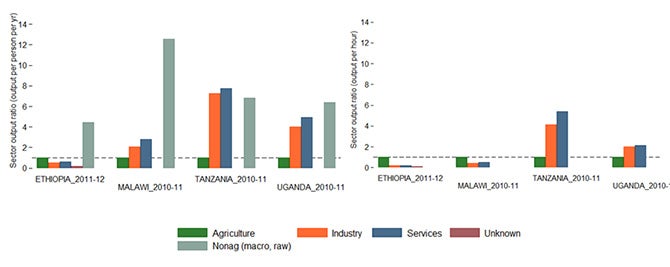Labor productivity in Sub-Saharan Africa has been garnering attention recently. Development economists focus on labor productivity because it tends to be strongly associated with overall well-being measures, especially for the poor, who are reliably endowed with time, but often little else in the way of productive assets.
Cross-sector gaps in labor productivity are key indicators of structural change, which is the economy-wide process by which labor shifts from low-productivity industries such as agriculture, to those that are higher-productivity, such as industry and services. This process underpins development and is premised on large cross-sector gaps in productivity. Economists expect these gaps to be quite large in the poorest countries, and to get smaller as labor shifts out of agriculture. Recent evidence suggests these forces are indeed at work in Sub-Saharan Africa.
In a new study focused on Ethiopia, Malawi, Tanzania and Malawi, I find that the agricultural sector is not necessarily a bastion of low productivity, as is commonly believed, but rather a large reservoir of underemployed workers. This result emerges when labor inputs are measured more carefully. Using the new LSMS-ISA datasets, I used micro-data to replicate the common patterns observed in macro statistics; that annual economic output per worker is lower in agriculture than in other sectors. While national statistics suggest that workers in these four countries are 6 times more productive outside of agriculture than in it, I predict the number is closer to 3.3x on average (See figure 1). This finding was consistent with those of Gollin et. al., who recently found that national accounts measures tend to under-estimate productivity in agriculture relative to other sectors.

Next, I took a closer look at labor inputs. Many workers are counted as agricultural because they spend at least some time working on farms. A striking pattern across household surveys is that agricultural workers work fewer hours per year -- 700 hours per agricultural worker compared to 1,900 hours per non-agricultural worker. Interestingly, it turns out that productivity in agriculture is a lot closer to productivity outside of it when one accounts for these differences in hours worked. On a per-hour basis, then, labor is only 1.6x more productive outside of agriculture.
Why don’t agricultural workers work more hours per year? While beyond the scope of my study, this question begs for more research. One explanation relates to agronomic conditions in Sub-Saharan Africa. Given a somewhat fixed supply of agricultural land, and limited water control, demand for farm labor is not well smoothed throughout the year. This could limit the ability of smallholder farmers to productively use more labor on their farms.
Another explanation for the employment gap is that few people are able to participate in non-farming activities. Non-agricultural wage employment is low, with 10% of adult individuals in rural areas participating. Self-employment outside of agriculture is also low, with 17% of adults in rural areas taking part. And though these activities are non-agricultural, closer examination of their descriptions suggests that they are indeed tightly linked to agricultural production.
These findings highlight the importance of thinking more about agricultural labor – not just counting workers, but finding ways for more people to productively supply more labor to agriculture, the dominant employment sector in Sub-Saharan Africa.
This is the sixth of a series of blogs dissecting our commonly held beliefs about Africa’s agriculture and its farmers. They draw on the findings of the Agriculture in Africa – Telling Facts from Myths partnership project led by the Chief Economist Office of the Africa Region of the World Bank.



Join the Conversation